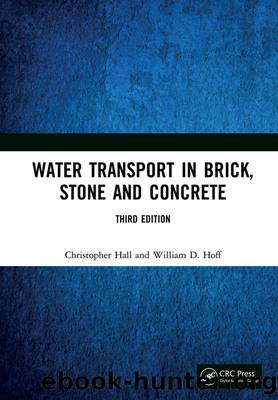Water Transport in Brick, Stone and Concrete by Christopher Hall;William D. Hoff;

Author:Christopher Hall;William D. Hoff; [Hoff;, Christopher Hall;William D.]
Language: eng
Format: epub
ISBN: 9780367371265
Publisher: CRC Press
Published: 2021-05-20T00:00:00+00:00
7Evaporation and drying
There are several ways in which water can enter the fabric of a building but there is only one important way in which water can leave it and that is by evaporation. Therefore evaporation has a central place in the description of water transport in brick, stone and concrete. By evaporation we mean the transfer of a substance (usually but not always water) from the liquid state to the vapour state and the associated transport of the vapour. If the rate of evaporation of water from a porous material exceeds the rate at which it is replaced by an absorption process, then the water content of the material falls and we speak of âdryingâ. However, quite apart from drying, evaporation plays a strong role in determining water distributions within structures or limiting wetting processes such as rising damp. It is the physics of evaporation which usually controls the behaviour of water at the boundary between a material and its immediate environment. There are therefore many water transport problems in which we need to apply an evaporation boundary condition. To put the point more strongly, it is the evaporation of water at building surfaces that drives the flow of moisture through building structures [501, 496].
It is through evaporation that salts crystallize on and within porous materials. It was with this in mind that Schaffer [1119] in his classic study of the weathering of building stones wrote: âFor a porous solid of appreciable thickness to dry completely, â¦water must travel in one form or another from the interior to the surface before it can escape as vapour into the surrounding air. The water lost from the surface by evaporation may be replaced by water flowing under the action of capillary forces from the interior to the surface, or the evaporating surface may fall below the surface of the solid, and water vapour must then traverse a certain length of pore space before it can escape at the surface.â Unsaturated flow theory now provides the means to represent the processes which Schaffer describes so clearly.
Download
This site does not store any files on its server. We only index and link to content provided by other sites. Please contact the content providers to delete copyright contents if any and email us, we'll remove relevant links or contents immediately.
| Automotive | Engineering |
| Transportation |
Whiskies Galore by Ian Buxton(41524)
Introduction to Aircraft Design (Cambridge Aerospace Series) by John P. Fielding(32884)
Small Unmanned Fixed-wing Aircraft Design by Andrew J. Keane Andras Sobester James P. Scanlan & András Sóbester & James P. Scanlan(32569)
Craft Beer for the Homebrewer by Michael Agnew(17927)
Turbulence by E. J. Noyes(7690)
The Complete Stick Figure Physics Tutorials by Allen Sarah(7135)
Kaplan MCAT General Chemistry Review by Kaplan(6589)
The Thirst by Nesbo Jo(6432)
Bad Blood by John Carreyrou(6271)
Modelling of Convective Heat and Mass Transfer in Rotating Flows by Igor V. Shevchuk(6219)
Learning SQL by Alan Beaulieu(6029)
Weapons of Math Destruction by Cathy O'Neil(5822)
Man-made Catastrophes and Risk Information Concealment by Dmitry Chernov & Didier Sornette(5641)
Digital Minimalism by Cal Newport;(5388)
Life 3.0: Being Human in the Age of Artificial Intelligence by Tegmark Max(5182)
iGen by Jean M. Twenge(5156)
Secrets of Antigravity Propulsion: Tesla, UFOs, and Classified Aerospace Technology by Ph.D. Paul A. Laviolette(4974)
Design of Trajectory Optimization Approach for Space Maneuver Vehicle Skip Entry Problems by Runqi Chai & Al Savvaris & Antonios Tsourdos & Senchun Chai(4837)
Electronic Devices & Circuits by Jacob Millman & Christos C. Halkias(4739)
